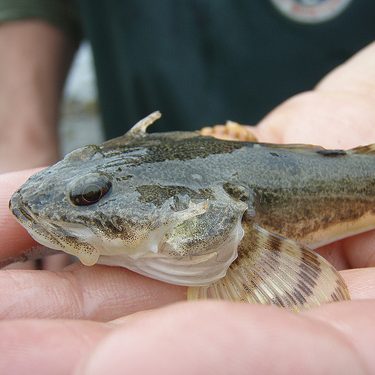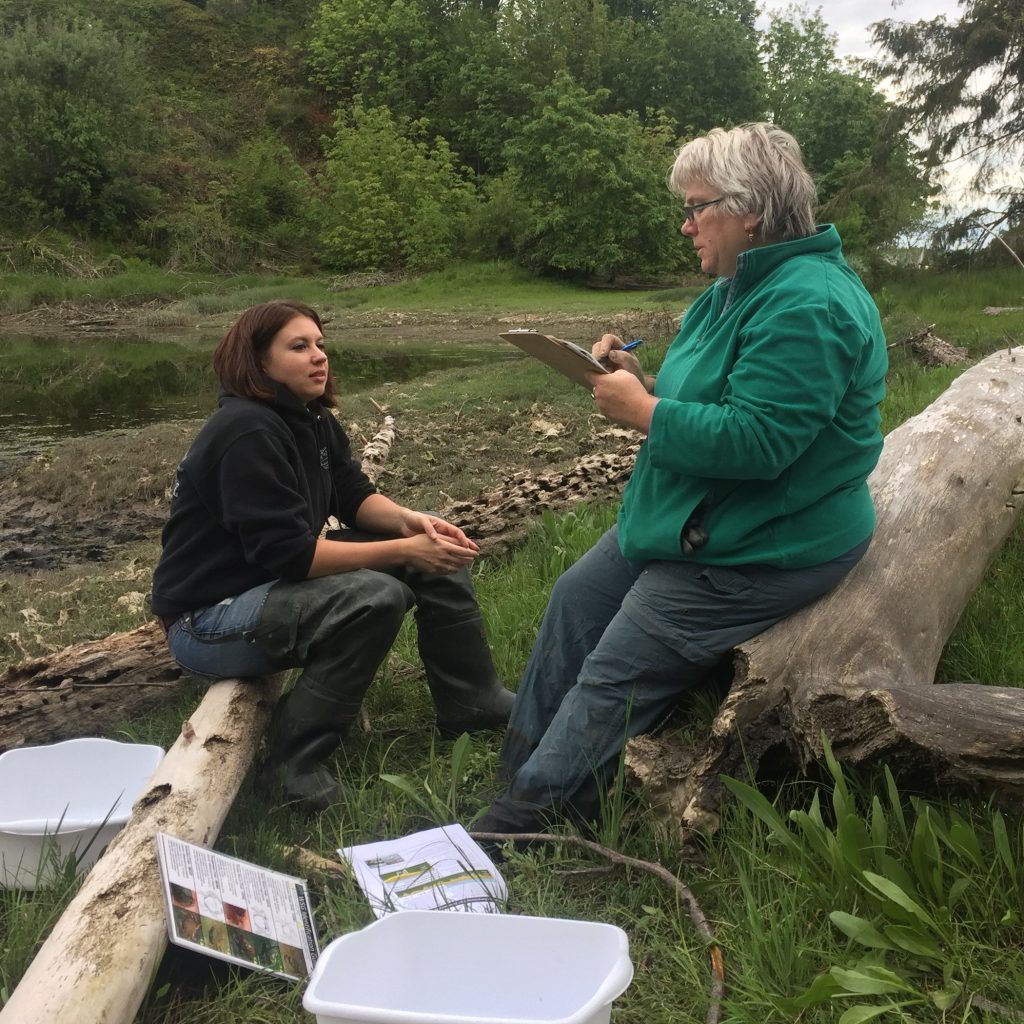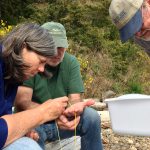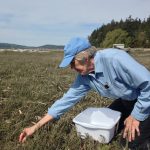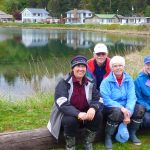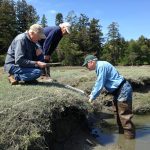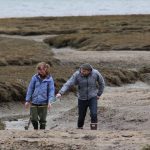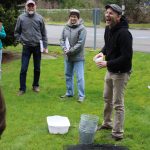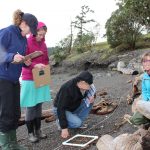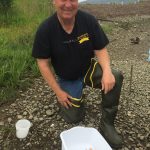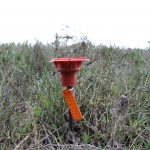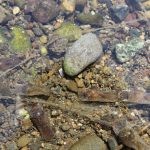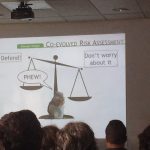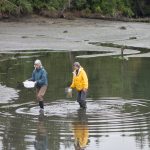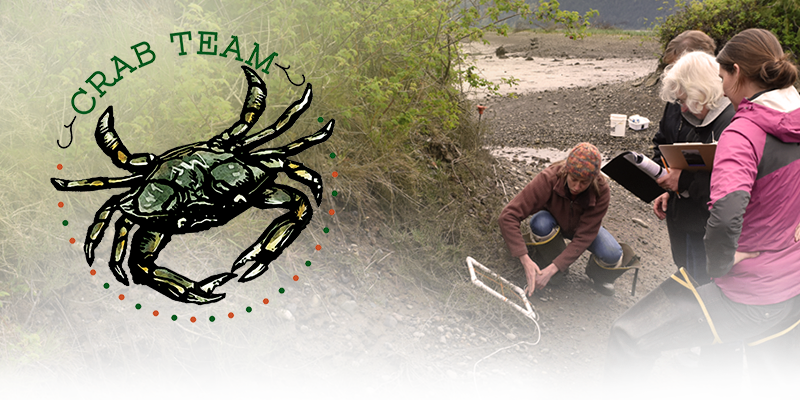
Crab Team Grows in 2016!
May 11th, 2016
The Crab Team was very busy over the winter gearing up for major growth. We logged a lot of miles cruising all over Puget Sound, the Strait, and the San Juan Islands to peruse shoreline, and get the word out. By the numbers, we held 5 outreach talks, and 8 training workshops with more than 60 volunteers, and set up 15 new sites (so far). Drumroll please: We now have more than 100 volunteers monitoring 23 sites all across inland Washington shorelines!
Data are in from all of the sites for April and May, and, so far, no green crabs have been found at any of our sites. However, 2015 and 2016 were good years for green crab reproduction on the outer coast (read why in this issue), meaning we have been hearing about more sightings in Willapa Bay. Green crabs have been observed off and on in Willapa since they first appeared in the Pacific Northwest in 1998, but until last year, they hadn’t been successfully trapped in Willapa since 2010. Getting our traps in the water this year was particularly important because good reproduction increases the chance green crab larvae could get washed further into the Salish Sea. Our volunteers are looking very hard for green crabs, which, of course, they hope never to see.
This growth wouldn’t have been possible without help from a host of local partners who helped us connect with new volunteers and access monitoring sites, and we are very grateful to them: Port Townsend Marine Science Center, Padilla Bay NERR, Feiro Marine Life Center, Poulsbo Marine Science Center, San Juan County Land Bank, Friends of the San Juans, Kitsap Beach Naturalists, Sound Water Stewards, Stream Team, The Swinomish and Suquamish Tribes, and numerous individuals!
What’s next for Crab Team? Believe it or not, we are very excited to be in the process of building a database for long-term data storage and retrieval. Sure it might not sound very flashy, but this database is the absolute foundation for building a useful and stable long term dataset – this is what gives all our data a chance at immortality! The database will enable us to enter information, and retrieve data for analysis with much greater efficiency than we currently are capable of. This means that you can look forward to more timely updates on what what our volunteers are seeing in the field!
Happy Summer Crabbing!
Crab Team
Green crabs: In hot water – and loving it!
When they are young, green crabs, a bit like toddlers, can be very picky about their surroundings and their schedule, and you can just imagine the temper tantrums! Green crabs hatch out of eggs, and emerge into the world looking very different from their final form. When they are part of the plankton, young zoea can swim a bit, but are mostly at the mercy of the tides and currents, so they don’t have much control over their experience. This is also the stage at which they can be moved around the coastlines, and transported to new ranges. Green crabs arrived in the PNW this way in the late 1990’s, swept all they way up from central California.
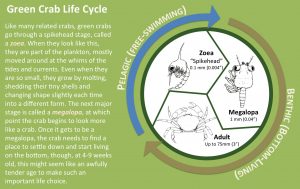
Green crab life cycle. Line drawings of zoea and megalopa by Auguste Le Roux (Own work) after Rice and Ingle 1975.
When they got to the PNW, green crabs survived and grew to maturity in the coastal embayments of Oregon and Washington (Coos Bay, Willapa Bay, etc.), but didn’t seem to be able to reproduce successfully. So, their numbers declined over the next several years. However, every few years since then, there seems to be a bump in recruitment. Researchers have been conducting ongoing tapping, to track the populations of green crab in these embayments, and noticed good years for baby green crabs in 2003, 2005, 2006, and 2010. Why those years? Were those green crab larvae coming from the local population? Or also part of a wave of California crabs swept north?
Recent research by scientists at Oregon State University and NOAA has looked at what is going on in the ocean during those years to try to understand what conditions create the Goldilocks “just right” for green crabs. It turns out the key factors appear to be warm sea surface temperatures, particularly those associated with the El Nino Southern Oscillation – ENSO, and warm trends in the Pacific Decadal Oscillation – PDO). These climate factors change the ocean to make it favorable for green crab larvae to get moved hundreds of miles up the coast, and arrive in time to settle in the coastal embayments that provide them with good habitat. In particular, green crabs like:
- Warm winter sea surface temperatures above 10 C (50 F). Warm water means the larvae can grow and develop more quickly.
- Northward currents that push the larvae toward good habitats.
- Nearshore water circulation that keeps the larvae from being carried out to sea.
On off years, the cold water means green crab grow very slowly or not at all. Even worse – for the green crabs, that is – the circulation pushes green crabs out to sea, where they won’t be able to survive when they have to transition into the bottom-dwelling megalopa stage.
This tells us that the most likely cause of those peaks in recruitment in, for instance, Willapa Bay, is the transport of larvae from California populations, which remain abundant, rather than larvae produced by a small number of crabs surviving in PNW bays.
Something different appears to be going on with established populations of green crab on the outer coast of Vancouver Island. In places like Barkley Sound, green crabs continue to become increasingly abundant, which suggests that those populations are reproducing successfully within the deep fjords. It’s possible that circulation patterns in coastal fjords keep the green crabs from washing out to sea more than those along the Oregon and Washington coastal embayments.
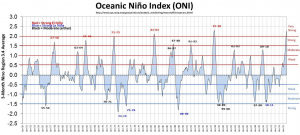
Oceanic Nino Index (ONI) a measure of the strength of ENSO trends. Data from NOAA plotted by Paul Huttner at MPR News.
What does this mean for inland Washington waters? It’s difficult to tell. This year is the strongest ENSO since the 1997-1998 event that originally moved green crabs north, which would predict a bumper crop of larvae. That could mean there is a greater chance of larvae getting further into the Salish Sea, either coming up the coast, or coming from the much closer population established in Sooke Inlet, just west of Victoria. So, if ever there was a time to make sure we have traps in the water, and people combing the shorelines looking for molts – that time is now. Even if green crabs do survive in our inland Washington pocket estuaries, will they be able to successfully reproduce and establish self-sustaining (or even booming) populations? Or will they gradually die off?
We still have a lot to learn about green crabs, and close monitoring of our shorelines is essential to determining what the long term status and effects of green crabs along inland shorelines will be.
Creature Feature: Staghorn Sculpin
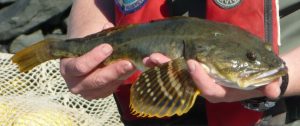
One of our favorite fishes is the staghorn sculpin, (Leptocottus armatus – LEAR, to our volunteers). That turns out to be a good thing, because, after shore crabs, staghorn sculpins are the most abundant organism in our traps, so we see quite a few.
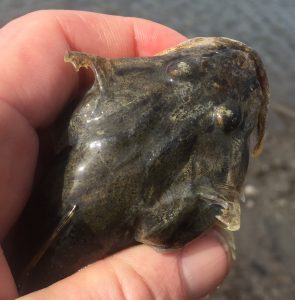
Wide head, and rounded snout of staghorn sculpin seen from above. The flared spines on the operculum pose a challenge to potential predators. Photo: PS McDonald
The other common name for staghorn sculpin is bullhead, and both of these names turn out to be helpful in identifying this fish. First, the characteristic that would most endear this species to Stannis Beratheon in Game of Thrones – the antler-like spines that adorn the upper edge of this fish’s gill cover (operculum). When agitated, the fish will flare the opercula out on either side of their head, which, combined with forked spines, makes it a much less-tempting snack for predators (unless of course, you start at the tail end). These forked spines are distinct among the sculpins we have here in pocket estuaries, and are a dead giveaway that the fish stuck in the trap (or stuck to your glove, so watch out!) is a LEAR.
The fish gets the name “bullhead” because of its big ol’ noggin. A wide head means a wide mouth too, which enables LEAR to eat larger prey than similarly-sized sculpins of other species. LEAR is a predatory fish that will eat most anything from A-Z (amphipods to zooplankton), but worms, shrimp, and crabs are among their favorite snacks (check out this video).
Because of their abundance and enormous appetite, these fish are extremely important to the structure and function of our local marine food web. In fact, these effects even extend to economically valuable fisheries and aquaculture. For instance, previous research has shown LEAR to be the most important consumers of baby Dungeness crab in some estuaries. In a field experiment, researchers tied young Dungeness crabs to a stake with fishing line, and used a hook on the line to capture fish that tried to eat the tethered crabs. The only culprit they caught? You guessed it: LEAR. You can read the full research paper here.
Another favorite food item for LEAR is native burrowing ghost shrimp, which are a major pest for the shellfish industry (read more about burrowing ghost shrimp here). Scientists have observed that sculpin keep these shrimp from being able to live beyond a certain depth in the water. Because burrowing shrimp mix up the sand and mud as they dig their burrows, they change the habitat for other species living there. By preventing burrowing shrimp from living at certain depths, staghorn sculpin indirectly determine what other organisms live in those areas too, without even touching them! More details on the research here.
In spite of the fact that they eat nuisance burrowing shrimp, Staghorn sculpin are not much favored by shellfish growers. As it turns out, LEAR also like to snack on the necks of small clams. They have a habit of nipping the necks, or siphons, of the clams, which forces the clams to climb up closer to the surface of the gravel or sand they are buried in. Being closer to the surface of the sediment makes clams more vulnerable to other predators like crabs, and this is bad news for clams that have (or had) short siphons to begin with. All in all, these little fish can have big impacts!
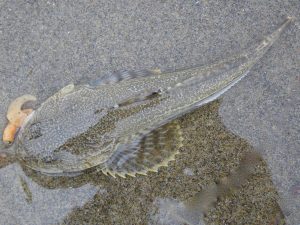
Staghorn sculpins are well-camouflaged against a sandy or muddy background. The black bars on their round, lobe-shaped pectoral fins help identify them.
Like most sculpins, LEAR spends most of its time sitting or swimming on or near the bottom. Its drab, mottled coloration is the perfect camouflage for muddy tideflats and cobble beaches. In addition to swimming from place to place, this fish uses large lobe-shaped pectoral fins to scoot short distances. These semi-transparent fins don’t look very beefy, but can provide impressive thrust when lunging for prey or making a quick get-away.
Pocket estuaries are critical nursery habitats for LEAR. Larvae settle into these habitats, and juvenile fish grow quickly in the warm, productive waters. Adult fish (5-6 inches) tend to move into deeper, cooler waters but some continue to migrate into estuaries at high tide to feed, particularly at night. While most LEAR caught in our traps are likely only 1-2 years old, these fish might live up to a decade and grow to more than a foot in length. Trust us, you wouldn’t want to go anywhere near the spines on a granddaddy LEAR!
So, the next time you bring up a LEAR in a trap (or on a fishing line, for that matter), take a moment to appreciate all of the characteristics that make it so well-suited to life in our local waters. These same features could make it a formidable predator of green crab too, and one of Mother Nature’s best defenses against that invasive species.
Site Spotlight: Butterball Cove
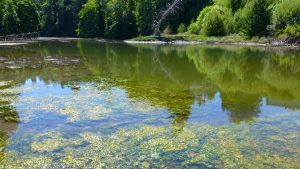
A river-otters eye view of the tranquil, reflective waters of Butterball cove.
With such an adorable site name, it was perhaps no surprise that we got to see a couple of playful river otters scamper across the berm at Butterball Cove on the first day of sampling last year. It was a great way to christen the launch of monitoring at this picturesque and tranquil lagoon deep in South Sound, not too far west of the Nisqually reach. Butterball Cove is a lagoon surrounded on two sides by steep hills, and cut off from the main part of the Nisqually Reach by a high berm, complete with an old hunting shack.
We were introduced to the site by Caitlyn and Wendy, from the South Sound Estuarine Association, and it wasn’t just the picturesque setting that suggested it would be a good monitoring site. As soon as we set foot in the lagoon, dozens of small native hairy shore crabs (Hemigrapsus oregonensis) scattered. Shore crabs are a good indicator that a site could be a good habitat for green crabs. European green crabs are actually also called “shore crabs” in the native range because they live fairly high on the beach, compared to larger types of crabs. Our shore crabs have similar habitat preferences to European green crabs, and are therefore a good indicator that the water is salty and cool enough, and that the area is protected from the larger crab species that would eat green crabs.
We also learned about the site from Anne Mills, who runs the citizen science program survey of Pigeon Guillemot (PG) breeding populations. Anne pointed out PG burrows high in the steep bluffs on the south side of the cove. The otters we saw were no strangers to science in their cove, Butterball has been a key site for PG monitoring as part of the Nisqually Reach Aquatic Reserve, and volunteers watch parents come and go, bringing fish to the burrow to rear their chicks.
Butterball Cove is a great example of how partnering with local organizations has helped us find great monitoring sites. Anne connected us with Gail, who lives at the top of the hill, and who helped us get permission from the neighbors to sample at this property. We always try to work with our site neighbors to make sure we don’t disturb their enjoyment of special places like this. We also hope that they will keep their eyes peeled for green crabs, because while our sampling takes place 6 times per year – they are there all year long, and can be a powerful early detection squad when they know what to look for.
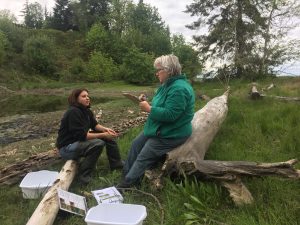
Caitlin and Gail at Butterball Cove
Gail not only helped us communicate with neighbors, but also threw herself into the project as a volunteer! She was joined at Team Butterball by Caitlin from SSEA and Raquel Crosier, who is a specialist in invasive species, formerly coordinating the Washington Invasive Species Council (WISC), which you might be familiar with because it is the central location for reporting invasive species in Washington (check our their app, too!).
Raquel, Gail, and Caitlyn make a great team, currently our southernmost site. You might be wondering why were are interested in a site so far from the potential source population in Sooke Inlet, BC. It’s true that we might not expect Butterball Cove to be the first place that green crabs show up in Puget Sound. The first answer to this is that this project is not only a green crab monitoring project but a pocket estuary project. We don’t know a lot about how these isolated habitats are being affected by all of the changes faced by the marine environment; ocean acidification, shoreline development, pollution, sea level rise, plastics, etc. This project will provide long term data that can help answer that question. In addition, if green crabs do arrive along inland Washington shorelines, we want to use our observations to learn about how green crabs are affecting habitats. The only way to know that is to compare sites with green crabs to sites that have never had green crabs at them, to see if they experience different changes over time that we can attribute to green crabs.
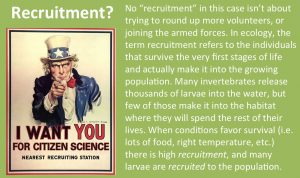 Lastly, though it seems unlikely, it’s entirely possible that green crabs could arrive everywhere in Puget Sound at one time. If green crabs have a very good recruitment year (see inset), we will only be able to tell how far they have gone into Puget Sound if we have sites looking everywhere. South Sound is a key part of that puzzle.
Lastly, though it seems unlikely, it’s entirely possible that green crabs could arrive everywhere in Puget Sound at one time. If green crabs have a very good recruitment year (see inset), we will only be able to tell how far they have gone into Puget Sound if we have sites looking everywhere. South Sound is a key part of that puzzle.
We hope to add more sites in South Sound as we continue to grow the program and for the time being, we are glad to have the team at Butterball as our Southern Sentinels.
Photo Gallery
Here are some of our favorite scenes from the last few months, including training workshops, site scouting, and sampling. We love to get the virtual experience of sampling with all of our volunteers – have a cool photo to share? Send it to crabteam@uw.edu.

